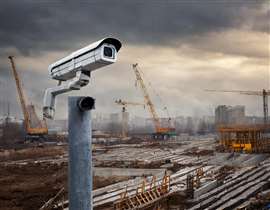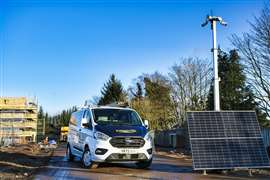Big Brother wants you to wear your hard hat
29 July 2024
AI-enabled CCTV cameras are increasingly being used around the world on construction sites to monitor safety. Lucy Barnard finds out what the tech is capable of - and asks what the implications could be for the future.
At the edge of a construction site on the Shetland Islands in Scotland, workers plod across the mud ready to start their shift. All goes smoothly until one man removes his hard hat. Suddenly an automated voice rings out over the loudspeaker system, “Please ensure your PPE is worn at all times.”
Watching them from a screen in a warehouse in Merseyside, six hundred miles away, Paul Worsley director of service for security firm Kingdom Systems, a company which specializes in providing CCTV cameras to construction sites, points to a box on the screen below each human figure.
 Image: Adobe Stock with AI
Image: Adobe Stock with AI
“What we’ve done here is to set up a virtual gateway using artificial intelligence,” he says. “So as each worker goes through, it goes green to say they’re ok. Everyone coming onto site needs to wear a hard hat and a hi-vis vest or the system picks it up. Then we can either send a mobile phone alert or a speaker alert. It’s just a flag to lift the level of health and safety on site.”
Closed circuit television cameras are a common feature on most modern construction sites where they are used to detect vandals and burglars.
For years these cameras, usually mounted on poles or perimeter fences were “dumb” devices which did not know what they were looking at, requiring security guards to watch them or scroll through footage after an incident has taken place.
However, advances in artificial intelligence along with the falling cost of so-called “smart cameras” themselves, have transformed the business of virtual surveillance on construction sites and elsewhere. Machine learning algorithms trained to recognize specific people, objects or behaviours are enabling the cameras to effectively notice changes in real time and flag them.
Camera suppliers say that the technology has the potential to dramatically improve health and safety on construction sites by stopping accidents before they happen, preventing theft, ensuring correct procedures are followed and even improving productivity.
On the other hand, opponents warn that in the wrong hands, the tech can be too intrusive, risks infringing individual freedoms and could create data vulnerabilities.
What can “smart” cameras do on construction sites?
Worsley estimates that in the UK alone, although around three quarters of all sites use CCTV of some sort for security, currently only around five percent use the technology as a way to improve health and safety.
Kingdom Systems, whose clients include rental company Sunbelt Rentals, construction and regeneration specialist Morgan Sindall Group and housebuilder Bellway, says that figures is set to grow as more contractors become aware of the possibilities.
Another health and safety benefit, Kingdom says, is that its cameras can also be set up to detect workers about to walk into the most dangerous parts of a site.
“Here you’ve got cranes moving things around the site so there’s a risk, so this area is classed as a hazardous area,” Worsley says pointing to his screen. “So, if someone walks into that space it flags a warning. That alert can then either go to the automatic speaker to say you’ve entered a restricted area, or it can go to the site manager’s phone. Again, it’s warning people of the risks before it becomes a real hazard.”
 A solar powered mast on site. Photo: Kingdom Systems
A solar powered mast on site. Photo: Kingdom Systems
The company has also rolled out a separate system designed to monitor the road surface outside construction sites which flags an alert when construction vehicles leave muddy tracks which could cause cars to skid.
“It’s about where you’ve got vehicles entering and exiting sites, perhaps carrying soil,” Worsley says. “The tyres are full of mud and the actually end up carrying mud onto the highway. At the moment, contractors have to make sure that highways are clean at all times so they are constantly sending out road cleaners to clean the highway even though half the time it is still clean. This way, they can actually monitor the highway and send out a cleaner as and when needed.”
Up close, the masts themselves look a bit like a fairly unsubstantial lamp post, comprising a portable unit on wheels with attached stabilisers and a retractable post with the camera and speakers perched on top. Masts can either be connected to the mains electricity supply, if available, or come fitted with solar panels and a methanol backup which can be used completely off grid.
How much do AI surveillance cameras cost to rent?
They come with tracking built into the towers which is activated if the towers are moved or disturbed without authorization. Kingdom says its towers cost around GB£275 (US$350) to rent a week and, for most medium sized sites to effectively monitor health and safety on site, it would recommend using around three of four cameras which should be frequently moved around the site as construction work progresses. Rental comes with access to the company’s rapid response teams and security patrols.
In June, the Singaporean government made it mandatory for all construction sites with a contract sum of SG$5 million (US$3.7 million) or above to install an AI-enabled video surveillance system for employee safety.
According to local media reports, contractors including Zheng Keng Engineering & Construction are using the system to detect safety breaches and employ analytics to find out the times and locations where rules are likely to be most frequently flouted.
And the possible applications don’t end there. AI-enabled CCTV cameras can also use facial recognition software to detect intruders on site.
 Paul Worsley, director of service, Kingdom Systems. Photo: Kingdom Systems
Paul Worsley, director of service, Kingdom Systems. Photo: Kingdom Systems
“Anyone that comes onto a building site should go through a full induction to say they have completed the health and safety briefing and that they are safe to go on site. So, when they do that, we capture them in our database and get them to sign to say they are happy to be in the database,” Worsley says. “Then if anyone comes onto the site that hasn’t been inducted or isn’t in the database, the system will flag it.”
Although a number of construction contractors are already using biometric scanners which take a photograph of workers’ faces in order to allow them onto site, the number of western construction contractors using the tech via CCTV.
Nonetheless, the technology is already being rolled out elsewhere. Many of the world’s largest supermarket chains already employ facial recognition technology for applications ranging from crime prevention to estimating the age of those buying alcohol while doctors use the tech to diagnose rare genetic disorders.
Governments around the world have increasingly turned to facial recognition systems to target suspected criminals and locate missing children – and sometimes to crack down on political dissent. In China, the world leader in facial recognition AI, the tech has become an integral part of daily life for millions.
Chinese contractors have been widely using the tech too.
According to a Report by the Chinese Academy of Sciences and published on the organisation’s website, the technology has been used by China National Petroleum Corporation on dozens of construction sites, has made “construction sites transparent,” and has shown significant improvements in both safety and productivity.
As well as sending safety alerts to remind construction workers to wear PPE and tracking hazardous areas, the tech also tracks people involved in forbidden activities such as fighting and can be used to spot “loiterers.”
Facial recognition tech; “a grey area”
Back in the UK, Kingdom Systems says that it is treading cautiously with its adoption of facial recognition technology.
“It’s a very grey area in terms of what you can and can’t do,” Worsley says. “To be honest, the laws are really behind times when it comes to a lot of this tech.”
“What you tend to find with facial recognition in a lot of cases is that you have an existing database – for example individuals recently apprehended for shoplifting for instance – and the system is set up to flag any matches,” Worsley adds. “We don’t touch those markets. We only work in controlled environments where everyone has given consent to being observed by cameras. Anyone who hasn’t gone through that process is actually trespassing.”
STAY CONNECTED



Receive the information you need when you need it through our world-leading magazines, newsletters and daily briefings.
CONNECT WITH THE TEAM








